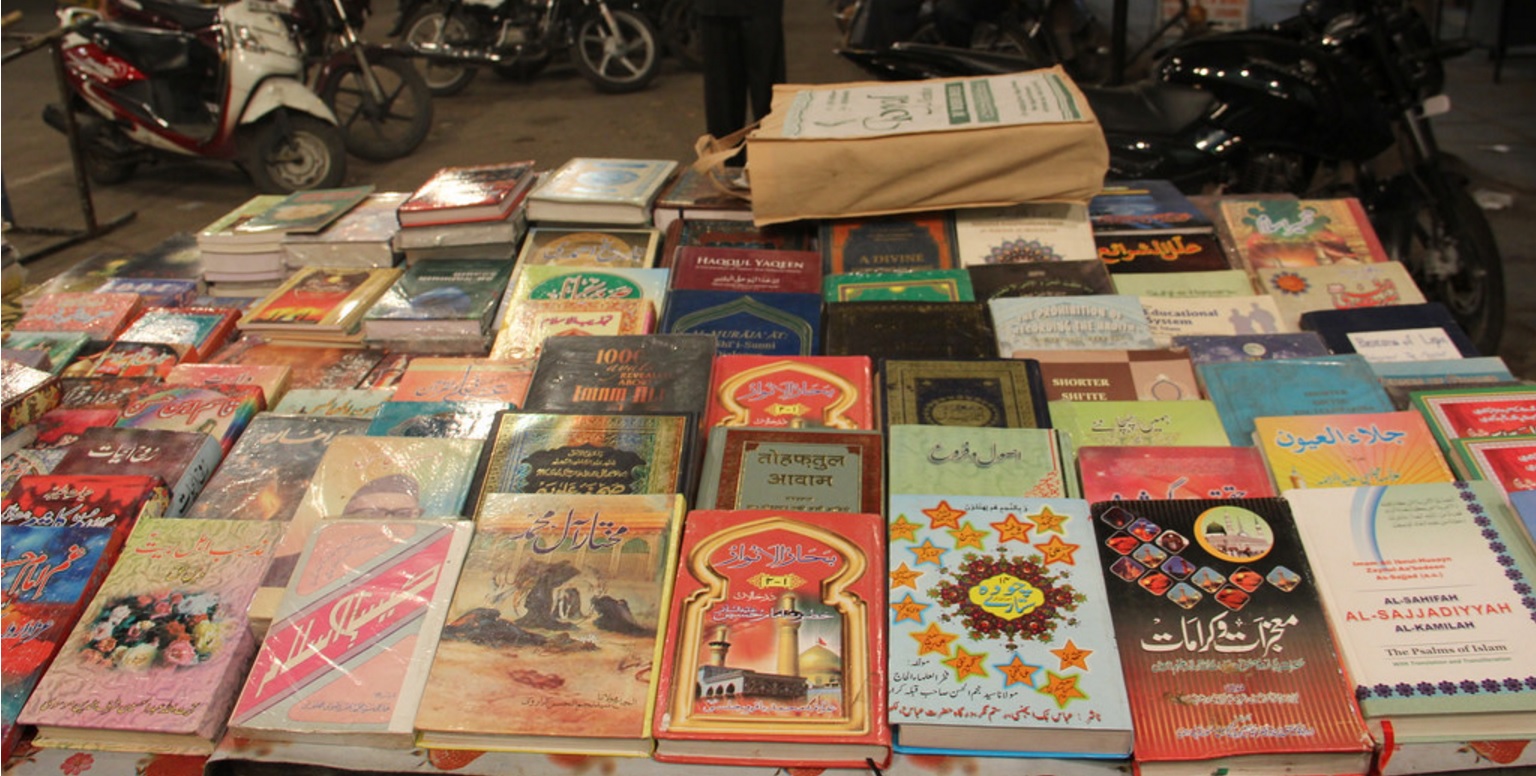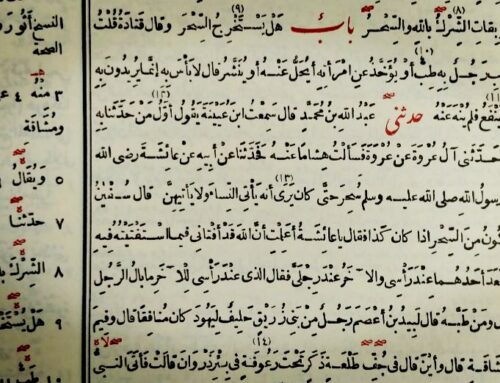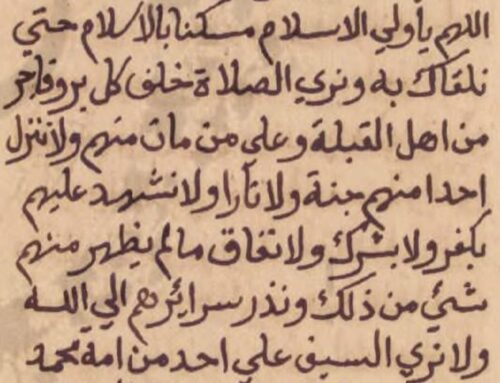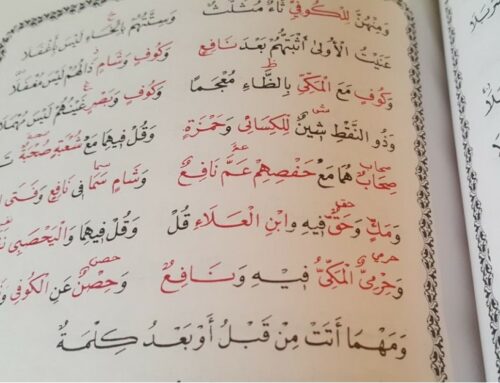(Translator’s Foreword: The following is a translation of an insightful piece written by Shaykh Muhammad Taha Karaan, in which he has succinctly discussed a number of salient features of the Shia hadith tradition, and also assessed how accurate the Shia are in their claim to taking their knowledge from a pure, unadulterated chain of inerrant imams.)
Introduction
The Ahl as-Sunna and Shi’a both share in taking the Qur’an as a source of religious legislation (tashri’), and despite the opinion of the Qur’an being tampered being common among the Shi’a, they are nonetheless ordered to rely upon the Qur’an currently in our midst, until the Hidden Imam appears.
Likewise, just as both groups deem the Qur’an a source of religious legislation, they also both rely upon the Sunna, except that the Shi’a concept of Sunna differs with that of the Ahl as-Sunna. We can disregard the finer distinction between the concepts of Sunna according to each group, and for practical reasons, conclude that the Sunna according to the Ahl as-Sunna is that which the hadith books of Ahl as-Sunna comprise. At the forefront of these books are the Six Books – the two Sahihs and the four Sunan collections – and the musnad and mu’jam collections. On the other hand, the Sunna according to the Shi’a is that which their hadith sources comprise, the most important of them being the Four Books (al-kutub al-arba’a): Al-Kafi of al-Kulayni; Man La Yahduruhu al-Faqih of as-Saduq ibn Babawayh; Tahdhib al-Ahkam; and Al-Istibsar, both by Abu Ja’far at-Tusi.
Whatever the case, both groups claim they are exclusively upon the truth which was revealed to Muhammad g, and that other groups besides them have erred from this truth, because they took the Sunna from the wrong people and trusted unreliable sources which were distorted at the hands of fabricators. It was hence vital to carefully consider what each group considers a reliable source of religious legislation.
As the Qur’an is a common denominator for both groups, albeit at a superficial level[1], the only option was to look at the Sunna and see which is the real Sunna of Muhammad (sallallahu alayhi wasallam): the Sunna of the Ahl as-Sunna or that of the Imamiyya Shi’a? With this purpose in mind, we shall shed some light upon the Sunna tradition according to the Shi’a.
And from Allah is all ability.
The Concept of Imama
The core belief of the Imamiyya[2] is Imama, the belief that Allah Most High appointed twelve imams after Muhammad g whose duty was to take charge of the heritage of the Prophet (sallallahu alayhi wasallam), and to protect and convey it; the imam is the sole conveyor from the Messenger (sallallahu alayhi wasallam). And to ensure his conveying was sound from lapses or mistakes, Allah Most High granted them inerrancy (‘isma), making them inerrant (ma’sum) imams, conveying one after the other in a manner that is divinely-protected by Allah from every human deficiency.
This succession continued through twelve imams, each imam having students who recorded the Sunna which they took from them. And why should they not record it, seeing that they are the inerrant imams and custodians of the heritage of their grandfather, the Chosen One (sallallahu alayhi wasallam)? How can they not write on their authority, when they are the treasurers of the knowledge of Muhammad (sallallahu alayhi wasallam); specifically appointed by Allah Most High to convey on behalf of the Prophet (sallallahu alayhi wasallam); with them are the Torah, Evangel and the Qur’an written by Amir al-Mu’minin; their and their forefathers’ status is greater than that of the Prophets of Great Resolve (Ulu’ l-’Azm); and every atom in the universe humbles itself before their power? For this reason, every imam was the sole inerrant authority, with respect to the Sunna, in his lifetime, whereas others were merely narrators who were either right or who had erred.
Hence, whatever books the students of a particular imam compiled during his lifetime, when a new imam would take the former imam’s place after his demise and become the new sole authority of the Sunna, it left no need for what his father’s[3] students had compiled.
Based on this, one would expect after a golden chain of inerrant imams, each with his own students who recorded the Sunna from him, that the Sunna of the followers of these imams would all trace back through this chain: the Twelfth Imam, from his father, from his father, from his father, until it reaches ‘Ali ibn Abi Talib h from Muhammad, the Messenger of Allah (sallallahu alayhi wasallam).
A Shi’a poet has actually boasted about this:
If you wish to choose a school for yourself,
Which shall deliver you from the flames of the Fire on the Day of Gathering,
Leave the opinions of Shafi’i, Malik, Ibn Hanbal, and what Ka’b al-Ahbar has related,
Take from people whose statements and narrations are: Our grandfather narrated from Jibril from the Creator.
Furthermore, the basis for the claim that the Sunna in its entirety should be narrated through this golden chain is that Allah’s care towards the Shari’a being soundly conveyed meant He did not suffice upon average narrators to preserve the Shari’a from being lost and to transmit it to future generations. Rather, Allah chose for this umma divinely-guided guides and inerrant imams. All of this was to ensure no mistake or lapse could seep into this great heritage. Thus, Allah was not going to let the umma depend on the narrations of human transmitters who were prone to human error and forgetfulness, as long as He had appointed for them those regarding whom none of the above was ever imaginable. This is the philosophy of inerrancy (‘isma) which the Shi’a claim for their imams.
Nonexistence of Shi’a Hadiths Through the Inerrant Chain
After explaining the concept, we move towards the ground reality and turn to the Shi’a books of hadith, to examine the extent of conformance to this concept. It is at this point we are left utterly surprised to realise we cannot find even one narration which has been related through this golden inerrant chain.
Let us take a few chapters from Usul al-Kafi[4] as an example:
Chapter on the Incumbence of Obeying the Imams. There are seventeen hadiths in this chapter:
- On the authority of Zurara from Imam al-Baqir
- On the authority of Abu ’s-Sabbah from Imam as-Sadiq
- On the authority of Bashir al-Attar from from Imam as-Sadiq
- On the authority of Husayn ibn al-Mukhtar from one of our companions from Imam as-Sadiq
- On the authority of Abu ’l-Hasan al-ATTar from Imam as-Sadiq
- On the authority of Abu ’s-Sabbah an-Kinani from Imam as-Sadiq
- On the authority of Husayn ibn Abi ’l-’Ala’ from Imam as-Sadiq
- On the authority of Ma’mar ibn Khallad from Imam ar-Rida
- On the authority of Abu Basir from Imam as-Sadiq
- On the authority of Muhammad ibn Zayd at-Tabari from Imam ar-Rida
- On the authority of Abu Salama from Imam as-Sadiq
- On the authority of Muhammad ibn Fudayl from Imam al-Baqir
- On the authority of Isma’il ibn Jabir from Imam al-Baqir
- On the authority of Abu Ishaq from one of the companions of Amir al-Mu’minin
- On the authority of Muhammad ibn Hazm from Imam as-Sadiq
- On the authority of Husayn ibn Abi ’l-’Ala’ from Imam as-Sadiq
- On the authority of ‘Abd al-A’la from Imam as-Sadiq
Although this is just one chapter, we chose it randomly upon opening the book, not through selection or browsing its pages. What the reader notices in the narrations of this chapter, namely that most of the chains converge at Imam as-Sadiq and Imam al-Baqir through the path (Tariq) of their students and not the imams from their progeny, is a phenomenon which is reflected throughout the book, and in fact, all four of their books.
If you find this issue surprising, what is more surprising is that there is not a single narration from the Twelfth Imam in Al-Kafi, despite al-Kulayni being a contemporary of all four of his emissaries (safir)[5]. Why does al-Kulayni rely on secondary narrators when he is able to take the Sunna from his contemporaries from Imam al-Mahdi, who had only been given inerrancy so he can convey “from our grandfather from Jibril from the Creator”?[6]
And if this left you astonished, here is something which will surprise you even more: ‘Uthman ibn Sa’id al-’Amri was the first emissary who benefitted from being in contact with the Hidden Imam, hence he was by virtue of this contact, the best narrator from the Hidden Imam from his forefathers. Despite this, we do not find a single narration of his from the Twelfth Imam in the Four Books. In fact, not even from the eleventh imam, whom he was known to have served. In Jami’ al-Ruwat[7], al-Ardabili mentions five of his chains in Al-Tahdhib and Al-Kafi, but none of them reach Hasan al-’Askari [the eleventh imam] or the Hidden Imam.
Below are these five chains:
- ‘Uthman ibn Sa’id al-’Amri; from Muhammad ibn Sulayman; from Maymun al-Ban; from Imam as-As-Sadiq
- ‘Uthman ibn Sa’id al-’Amri; from ‘Abd al-Karim al-Hamdani; from Abu Tumama; from Al-Imam al-Jawwad
- ‘Uthman ibn Sa’id al-’Amri; from a man; from Imam as-As-Sadiq
- ‘Uthman ibn Sa’id al-’Amri narrates from his dream of Al-Qa’im
- ‘Uthman ibn Sa’id al-’Amri; from ‘Abd al-Hamid ibn ‘Ali al-Kufi; from Muhajir al-Asadi; from Imam as-Sadiq
This will definitely raise many questions in the reader’s mind. Did al-’Amri not have any occupation besides amassing wealth and producing letters?[8] Did al-Kulayni, his contemporary in Baghdad, not find in these letters anything worthy of inclusion in his book? Was there nothing more to those letters besides cursing the accursed individuals who competed with al-’Amri and his son to be emissaries of the Hidden Imam, and praising those emissaries who were entrusted with collecting the Khums[9] and the share of the imam?
Let us leave the father and move to the son, Muhammad ibn ‘Uthman, the second emissary who remained at this post for close to half a century. Al-Ardabili tells us that Shaykh at-Tusi has mentioned in Al-Fihrist that Muhammad [ibn ‘Uthman] ibn Sa’id did not narrate from any of the imams, and this was by writing the symbol لم with his name.[10] Fifty years yet not a single narration from the imam he claims to meet. “Indeed, this is a thing intended. We have not heard of this in the latest religion. This is not but a fabrication.”
As for the single narration al-Ardabili[11] narrated from the third emissary, Abu’l-Qasim Husayn ibn Ruh an-Nawbakhti, in Al-Tahdhib[12], it is from Abu ’l-Qasim; from Muhammad ibn Ziyad; from Abu ’l-Hashim al-Ja’fari; from Imam al-Jawwaad.
The fourth emissary, Abu ’l-Hasan as-Samarri is the most destitute among them in narration: no narration from him in the books of hadith nor any mention of him in the earlier biographical collections. According to Jami’ al-Ruwat, his first listing as a narrator appears as late as Ibn Mutahhar’s eighth century list, Al-Khulasa.[13]
The Real Sources of Shi’a Hadiths
It is established from what has passed that the inerrant chain has not played for the Shi’a the role for which Allah had made it inerrant. So we ask: if the authors of the four books did not rely upon this chain in acquiring the Sunna, what did they rely upon? And if they did not take hadiths directly from the imams of the Ahl al-Bayt, whom did they take it from? The answer to this has been briefly alluded to in some of what he mentioned previously, but now we shall answer in detail.
The sources from which these authors acquired the Sunna are the books which the students of the imams, in particular Imams al-Baqir and as-Sadiq, compiled. These books are known by the Shi’a as the Four Hundred Sources (al-Usul al-Arba’umi’a). Shaykh as-Saduq and Shaykh al-Ta’ifa Abu Ja’far at-Tusi have, in a very lucid and satisfactory manner, explained to us that they rely upon these sources, as they do not quote any hadith in their books with their own complete chains of transmission, but rather the chain starts by mentioning the author of the particular relied-upon amongst the Four Hundred Sources. They have mentioned at the end of Al-Faqih [i.e., Man La Yahduruhu al-Faqih], Al-Tahdhib and Al-Istibsar the shaykhs through whom their chains trace back to the authors of the Four Hundred Sources, albeit there is some discrepancy in these chains of teachers too. In short, their reliance upon these sources is true beyond any doubt.
As for al-Kulayni, his methodology in narrating hadiths is different to that of his two colleagues; he narrates the full chain from himself to the imam. If this casts a doubt on al-Kulayni’s reliance upon these sources, al-Taqi al-Majlisi has affirmed that al-Kulayni is no different to Ibn Babawayh and aT-Tusi with respect to relying upon the Four Hundred Sources.
He says in his commentary of Al-Faqih, entitled Rawdat al-Muttaqin:
It is apparent that the two Shaykhs transmitted everything in the two books from the Four Hundred Sources, upon which the True Sect relies, as stated by as-Saduq. The same is understood from the words of Thiqat al-Islam [al-Kulayni].[14]
To emphasise further, we relate what one of the great Shi’a scholars said in this regard. As-Shahid ath-Thani Zayn ad-Din al-’Amili says in his book, Ad-Diraya:
The earlier scholars compiled the hadiths which had reached them from our imams – may Allah’s peace be upon them – into four hundred books they named the Sources (al-Usul) and upon which they relied, such as the Asl of Jamil ibn Darraj, the Asl of Zurara, and so forth. Some of our elders embarked on compiling and sequencing them into specific books, to make them more accessible to the reader. The best of them are the Four Books which are relied upon in this era. They are Al-Kafi of Muhammad ibn Ya’qub al-Kulayni (d.329 ah), in which he gathered different types of hadith; Man La Yahduruhu al-Faqih of Abu Ja’far Muhammad ibn ‘Ali ibn Babawayh al-Qummi (d. 381 ah), in which he gathered the hadiths of rulings from the Sources; and At-Tahdhib and Al-Istibsar of Shaykh Abu Ja’far Muhammad ibn al-Hasan at-Tusi (d. 460 ah) in which he also gathered just hadiths of rulings.”[15]
Hence, the reliance of the authors of the Four Books on the Four Hundred Sources and their taking therefrom is an undisputed matter.
Let us now move to defining the period in which the Four Hundred Sources were compiled. Here too, Shi’a scholars have saved us the difficulty of investigating the matter. “And sufficient was Allah for the believers in battle”.
‘Allama al-Mamiqani states in Miqbas al-Hidayah fi ‘Ilm ad-Diraya:
It is commonly stated by the scholars, rather in their books too, that the Four Hundred Sources were compiled in the era of our master as-Sadiq (alayhis salam) according to some, or in the era of both Sadiqs (alayhimas salam) (i.e., al-Baqir and as-Sadiq) according to another, or in the era of as-Sadiq and al-Kazim (alayhimas salam) as mentioned by at-Tusi in I’lam al-Wara, where he says: ‘Four thousand people among the renowned people of knowledge narrated from as-Sadiq (alayhis salam). Four hundred famous books were compiled from his answers to questions, known as al-Usul, and which were narrated by his students and the students of his son, Musa (alayhis salam).’”[16]
One who has read the beginning of this article must note the connection between what al-Mamiqani has mentioned here on the authority of Tabrasi and the chapter of Al-Kafi which we presented as an example.
Inconsistency in Shi’a Hadiths
It is clearly established from what has already passed that with respect to the Sunna, the Shi’a depend on their books, the most important of them being the Four Books, just as it is established that these books trace their origins back to the Four Hundred Sources, and that these four hundred compilations appeared in the era of Imam as-Sadiq, his father al-Baqir, and his son al-Kazim.
From this point we move to another very critical phenomenon, which is the issue of inconsistency in Shi’a hadiths. However, before going to the depths of this discussion, we would like digress by postulating another issue, namely that these sources should enjoy a high level of credibility and authenticity. This is because it is supposed that their authors compiled them in light of what they took from the imams, and at times they would also present these books to them. For this reason, reliance upon these books was widespread amongst the early Shi’a scholars.
The first Majlisi [the father of Baqir Majlisi] says in his Sharh al-Faqih:
Undoubtedly, the reliance of our early scholars was on the books narrated by the reliable companions of the imams…They recorded what they heard from them in their books, and these books were authentic according to the scholars.”[17]
This is what also prompted the authors of the Four Books to place uncritical reliance upon the Four Hundred Sources.
Ibn Babawayh said in the introduction to Al-Faqih:
I wrote this book by removing the chains, so that its paths of transmission are not too many…Everything contained in it has been extracted from renowned books which are relied upon and which are referred back to.” [18]
Thus, he had every right to say in the preface to his book that he will only include in the book that which he agrees with, affirms as authentic and considers a proof (hujja) between him and his Lord.
Likewise, AT-Tusi paid great attention to giving preference to and reconciling between differing hadiths. However, you will rarely see him preferring one hadith over the other due to one being weak.
It is also clear from al-Kulayni’s preface that he trusts what he has narrated in his book. He addresses the person who requested him to compile the book as follows:
And you said you would like to have a book which suffices, gathering therein from all branches of religious knowledge that which the student can suffice upon, and to which a seeker of guidance can refer, and from which he may take who seeks knowledge of the religion and wishes to act upon authentic narrations of the truthful (alayhimus salam) and practiced sunan…And Allah made easy, and to Him belongs praise and favour, compiling what you asked. I hope it is as you anticipated.[19]
Moreover, when the Four Hundred Sources were trusted, it is only logical that we should find therein the knowledge of the family of Muhammad (sallallahu alayhi wasallam), pure and impeccable, and harmonious without any crookedness or discrepancy, as “had it been from other than Allah, they would have found much discrepancy therein”. It was also expected that the Four Books, due to their content being taken from the Four Hundred Sources, will reflect the same harmony and consistency.
However, what the reader of these books will encounter is something starkly different. What you will find when looking into them is discrepancy in its most ugly form. If you think I have fallen into this extreme mode of expression due to becoming a victim of bias, listen with me to what Shaykh at-Tusi said in the beginning of his At-Tahdhib, immediately after praising Allah and sending blessings on the Prophet (sallallahu alayhi wasallam):
One of my friends amongst those whose right upon me is binding- may Allah support him – discussed with me the hadiths of our people – may Allah support them and have mercy on the predecessors among them – and the difference, incongruity, contradiction and disparity which has occurred in them, to the extent that rarely will there be a narration except that in opposition to it, there is that which contradicts it, and no hadith is safe from being opposed by that which negates it. Our opponents have made this one of the biggest attacks on our school and have used this as a route to nullify our creed. They said, ‘Your shaykhs from the predecessors and the successors have always criticised their opponents for the differences they follow, and they vilify them over disunity in subsidiary matters, mentioning that it is impermissible for a person of wisdom to adopt this as a religion and for a person of knowledge to allow this to be practiced. However, we have found you to differ even more than your opponents and to conflict with each other more than your adversaries. The existence of this difference on your part, despite your believing this to be falsehood, is a proof of the invalidity of the source.’ This reached the extent that doubts crept into a group of them who are not strong in knowledge nor do they have insight into the modes of contemplation and meanings of words. Many of them retracted from the truth when the reason behind this [i.e., this difference] was unclear to them and they were unable to solve the doubt therein. I heard my shaykh, Abu ‘Abdillah [al-Mufid] – may Allah support him – mention that Abu ’l-Husayn al-Haruni al-’Alawi used to believe the truth and follow the belief of Imama. However, he retracted from it, when the matter of differences in hadith became confusing for him. He left the school and practiced something else, when the different meanings therein were not clear to him.”
It was this phenomenon of gross and ubiquitous discrepancy that spurred Shaykh at-Tusi to compile At-Tahdhib. Once his book At-Tahdhib became renowned, some asked him to separately compile the hadiths in which there was discrepancy. Hence, he wrote his second book Al-Istibsar, whose full name Al-Istibsar fi ma ukhtulifa min al-akhbar (Contemplating the narrations in which there is discrepancy) discloses its real essence. Specifying two books amongst four books of hadith, due to inconsistency in the texts, is the clearest proof of the true extent of this discrepancy. However, we cannot stop here out of astonishment, but rather pose another bitter question: what could the cause of this unsightly discrepancy be, which was condemned by this group among the Imamiyyah, whose disavowing of Imamiyyah Shiaism and its beliefs was lamented by at-Tusi? This is where the heart of the matter lies.
As a preface to uncovering this secret, I would like readers to imagine the following scene: a man is sat with us, and surrounding him are a group of people who are speaking in his name, except that they are all essentially lying and fabricating against him what he did not say. Each one of them is speaking independently of the other, without them uniting amongst themselves to achieve a uniform statement. Even if this unification occurs at times, it is non-existent for the majority of the time. So I ask you in the name of Allah: is it not natural that there will be discrepancy and inconsistency between what all these liars all say in the name of this one person?
Take into consideration how many liars had gathered around the imams of the Ahl al-Bayt, to the extent that Imam as-Sadiq said, “Not a single one of us (imams of the Ahl al-Bayt) is safe from liars.” Take into consideration the extent to which these narrators were affiliated to extremist sects, regarding whom Imam as-Sadiq said, “Amongst them are those who lie, such that even Satan needs their lies.”[20] Also consider the fact that a number of the authors of the Four Hundred Sources were of incorrect belief.
Miqbas al-Hidaya of al-Mamiqani states:
Al-Mawla al-Wahid related from his maternal uncle, al-Majlisi (the second), and also his grandfather al-Majlisi (the first) that being an author of one of the Sources is amongst the causes of excellence, but he himself scrutinised this, considering that many of the authors of the Sources had adopted incorrect beliefs, albeit their books are reliable, as clearly stated at the beginning of Al-Fihrist.”[21]
Thereafter, al-Mamiqani presents ‘Ali ibn Abi Hamza al-Bata’ini as an example, who wrote many books and a complete commentary of the Qu’ran, except that Ibn Faddal said about him: “A liar, accused [of lying], accursed…I do not consider it lawful to relate even one hadith from him”[22]
If you consider all of this, it will become totally clear to you, if Allah wills, that this huge heritage which the Shi’a boastfully attribute towards the imams from the family of Muhammad (sallallahu alayhi wasallam) is nothing but a caricature of what Allah said: “So woe to those who write the “scripture” with their own hands, then say, “This is from Allah,” in order to exchange it for a small price. Woe to them for what their hands have written and woe to them for what they earn.”[23]
And if you want proof for this, look for it in the principle which Allah Most High informed us of when He said: “If it had been from [any] other than Allah, they would have found within it much contradiction.”[24]
And if you want to find out the identity of those who are accused of this great lie, look at what al-Mamiqani said:
It is commonly stated by the scholars, rather in their books too, that the Four Hundred Sources were compiled in the era of our master as-Sadiq (alayhis salam) according to some, or in the era of both Sadiqs (alayhimas salam) (i.e., al-Baqir and as-Sadiq) according to another, or in the era of aS-Sadiq and al-Kazim (alayhimas salam).[25]
Having read this, you will now hopefully realise:
- why there are so few narrations from the latter imams in the books of the Shi’a
- why they completely ignored the divinely-inerrant chain of narration of the imams
- why, in transmitting the Sunna, their exclusive reliance is upon suspicious and mendacious persons who turned Imam Ja’far as-Sadiq into the pseudo-source for the lies which they then spread in his name.
- and how all of that turned into the self-contradictory mass of narrations that is the hadith of the Shi’a.
When you see al-Kulayni turn away from narrating the hadiths of the Ahl al-Bayt through the chain of Imam al-Mahdi, from Imam al-’Askari, from Imam al-Hadi, from Imam al-Jawwad, from Imam ar-Rida, from Imam al-Kazim, from Imam as-Sadiq, but you see he is very happy to acquire the Sunnah from ‘Ali ibn Ibrahim al-Qummi, from Ahmad ibn Muhammad al-Barqi, from ‘Ali ibn al-Hakam, from ‘Ali ibn Abi Hamza al-Bata’ini, from Abu Basir, from as-Sadiq, then know the secret behind this and do not be from the absentminded!
We ask Allah to protect our religion for us.
All praise belongs to Allah in the beginning and the end. May Allah bless and send peace on our leader Muhammad, his family and his companions.
Click here to Download a PDF Version: Implications of Inconsistency in Shia Hadiths
[1] In light of the many Shi’a narrations which state the Qur’an was tampered with and is currently not in its original form
[2] Commonly referred to as the Ithna ‘Ashariyya
[3] i.e., the previous imam
[4] Volume 1, page 108
[5] It was believed that the Hidden Imam had emissaries who met him and relayed messages on his behalf to the people, after he went into hiding.
[6] It is appropriate to mention that I came across this point when I heard a Shi’i say that Imam al-Bukhari deviated from the Ahl al-Bayt, as he had abandoned narrating from Imam Hasan al-’Askari, despite being his contemporary. I researched the matter and said to him, “If this proves that Bukhari was a NaSibi [an opponent of the Ahl al-Bayt], al-Kulayni is the greatest NaSibi.” It then became clear to me that this objection stems from ‘Abd al-Husayn in al-Muraja’at (Shaykh Taha Karaan).
[7] Volume 1, Page 533
[8] Claimed to be from the Hidden Imam and sent to the Shi’a via al-’Amri
[9] A substantial tax collected on behalf of the imam
[10] Jami’ al-Ruwat , Volume 2, page 148. لم was a symbol to denote there are no narrations from him.
[11] Jami’ al-Ruwat , Volume 1, page 240
[12] Al-Tahdhib, Volume 6, page 93
[13] Jami’ al-Ruwat , Volume 1, page 598
[14] Rawdat al-Muttaqin, Volume 1, Page 28
[15] Ad-Diraya, Page 7
[16] Miqbas al-Hidaya, Volume 3, page 20
[17] Rawdat al-Muttaqin, Volume 1, page 130
[18] Al-Faqih, Volume 1, page 12
[19] Al-Kafi, Volume 1, page 49
[20] Miqbas al-Hidaya, Volume 2, page 403
[21] Miqbas al-Hidaya, Volume 3, page 33
[22] Jami’ al-Ruwat , Volume 1, page 547
Fabricate
[23] Qur’an, 2:79
[24] Qur’an, 4:82
[25] See footnote 17








Leave A Comment